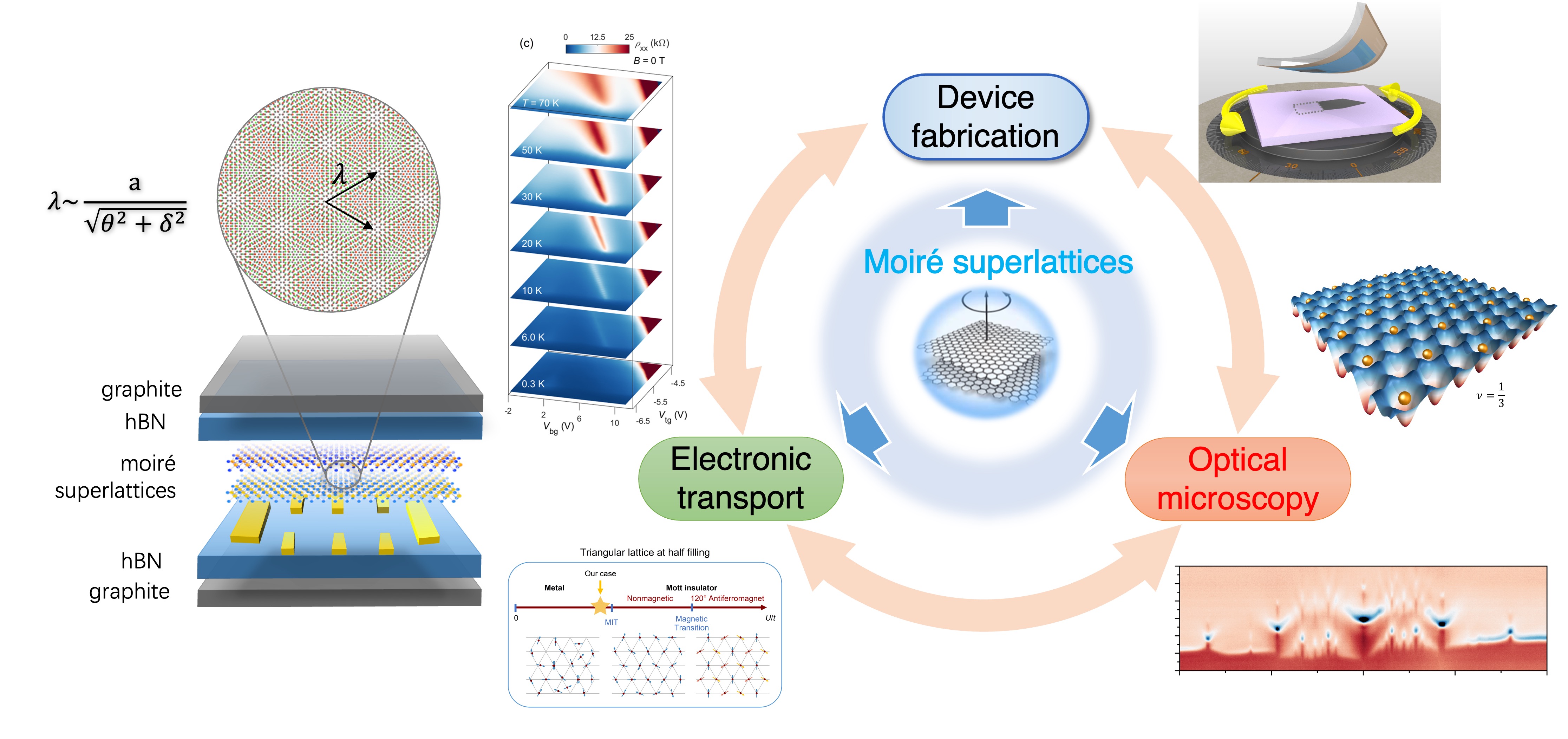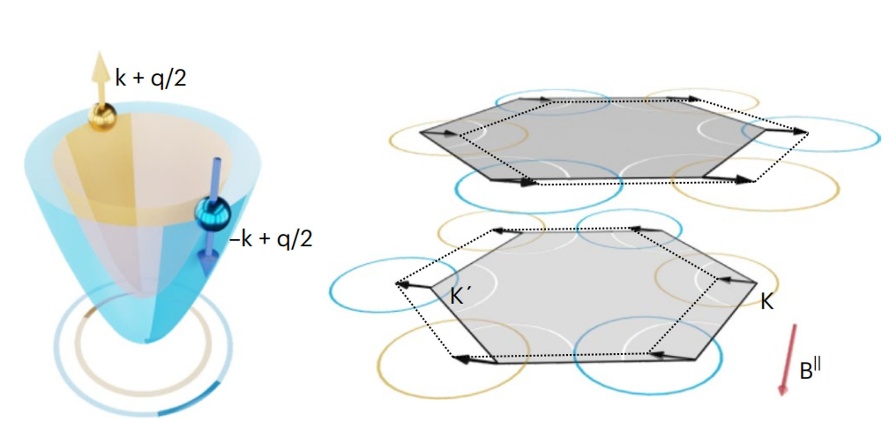The focus of our research is exploring the novel electronic transport and optical properties of low-dimensional quantum materials. While transport measurements typically detect responses near the Fermi surface using electric fields in the DC limit, optics probe these materials with optical electromagnetic waves. In our lab, the study of these properties typically involves extreme conditions like low temperatures (down to 10 mK) and high magnetic fields (up to 17 T). Regarding the object of study, we are dedicated to building various types heterostructures using different layered materials as building blocks. Additionally, we are actively working to develop new cutting-edge methods to detect and manipulate these materials. Through the combined efforts, we aim to unravel the interplay between intricate interface effects, electron correlations, and topological phenomena. Our research holds the potential to lead to development of functional devices in fields such as topological electronics, spin/valleytronic and optoelectronics.
Recent topics:
1. Moiré Superlattices:
Moiré superlattices emerge when two stacked materials have a slight lattice or angle mismatch, forming interference patterns with enlarged real-space periodicity and reduced bandwidth in the momentum space. They have offered a new paradigm for the study of strong electronic correlations, non-trivial band topology, and various emergent phenomena. Prof. Xu started to work on twisted bilayer graphene back to 2016. At N08, we build different types of moiré superlattices and investigate them from multiple perspectives such as the electronic transport and optical spectroscopy.The flatbands and quenched kinetic energy allow us to observe the abundance of correlated insulating states at fractional fillings in moiré heterobilayer WSe2/WS2 (ref.5). We have been able create moiré magnet (twisted bilayer CrI3) and observe the coexistance of ferromagnetic and antiferromagnetic ground states (ref.4), indicating that the stacking and angle-misalighment of 2D magnets can have profound effect on their magnetic properties. Recently, we have observed the trapping and manipulation of Rydberg excitons by moiré potentials (ref.1).

Our recent publication about this topic:
- Observation of Rydberg moiré excitons. Science 380, 1367-1372(2023).
- Tuning Quantum Phase Transitions at Half Filling in 3L-MoTe2/WSe2 Moiré Superlattices. Physical Review X 12, 041015 (2022).
- A tunable bilayer Hubbard model in twisted WSe2. Nature Nanotechnology 17, 934-939 (2022).
- Coexisting ferromagnetic–antiferromagnetic state in twisted bilayer CrI3. Nature Nanotechnology 17, 143-147 (2022).
- Correlated insulating states at fractional fillings of moiré superlattices. Nature 587, 214–218 (2020).
2. Topological materials:
We are working on fabricating high-quality nano-devices based on topological materials and exploring interface engineering. This development aims to facilitate the study of their intrinsic transport properties, the role of electron-electron interactions, topological phase transitions, and potential applications in topological electronics and spintronics. Additionally, we will explore the growth methods for new types of magnetic thin films with topological electronic band structures, aiming to reveal novel transport properties arising from the interplay between topology, magnetism, and strong correlations.

Our recent publication about this topic:
- Gate-tunable multiband transport in ZrTe5 thin devices. Nano Letters 23, 5334-5341(2023).
3. Rydberg sensing and manipulation:
Rydberg excitons are highly excited electron-hole pairs generated through photon excitation in semiconductors. In recent years, with the development in the field of two-dimensional materials, the study of Rydberg excitons has gradually extended into two-dimensional space. The solid-state nature of Rydberg excitons, combined with their large dipole moments, strong mutual interactions, and greatly enhanced interactions with the surroundings, holds promise for a wide range of applications in sensing, quantum optics, and quantum simulation. For instance, their sensitivity to dielectric screening can be utilized to explore novel quantum states and quantum phase transitions in proximity to two-dimensional electronic systems, known as Rydberg sensing—a technique that we have pioneered (ref. 2 and 3). By employing the moiré potential generated in two-dimensional moiré superlattices, spatial confinement and manipulation of these Rydberg excitons can be achieved, leading to the discovery of Rydberg moiré excitons in the strong coupling limit (ref. 1).

Our recent publication about this topic:
- Observation of Rydberg moiré excitons. Science 380, 1367-1372(2023).
- Creation of moiré bands in a monolayer semiconductor by spatially periodic dielectric screening. Nature Materials 20, 645–649 (2021).
- Correlated insulating states at fractional fillings of moiré superlattices. Nature 587, 214–218 (2020).
4. Pressure control:
We are presently in the process of developing an experimental setup that will enable in-situ pressure adjustments for nano-devices constructed from low-dimensional quantum materials. The application of hydrostatic pressure proves to be an effective pathway for reducing the van der Waals gap between layers and significantly enhancing interlayer hybridizations.

5. Unconventional superconductivity and Berry phase physics in non-centrosymmetric systems:
Materials without inversion center is an intriguing platform hosting multiple orders and non-trivial topological properties. The synergetic interplay between these degrees of freedom leads to rich quantum phenomena which can be captured by magneto-transport measurements at low temperatures. One example is the counterintuitive yet experimentally verified finite-momentum pairing state [1]. The ongoing project focuses on its possible existence and other unconventional pairing schemes in a variety of van der Waals heterostructures. Symmetry, ferroelectricity [2] and the Berry phase are considered as key parameters in understanding novel experimental implications in these systems. The project is supported by the National Science Foundation of China and the Ministry of Science and Technology.

Our recent publication about this topic:
- Evidence of finite-momentum pairing in a centrosymmetric bilayer. Nature Physics 19, 1599-1604 (2023).
- Depolarization of multidomain ferroelectric materials. Nature Communications 10, 2547 (2019).
Lab facilities:
Our lab has already established a set of advanced experimental facilities capable of thin film growth, nanofabrication, and conducting transport/optical studies at low temperatures and under high magnetic fields. The main equipments in our lab include:- A top-loading dilution refrigerator from Oxford Instruments, which can cool electron temperatures to as low as 15 mK and is equipped with a 15 T superconducting magnet.
- A He-3 cryostat from Oxford Instruments (300 mK, 9 T).
- A He-4 cryostat from Janis Inc (1.5 K-325 K, 9 T).
- An Attodry 2100 cryostat (1.7 K-300 K) equipped with vector magnets (9 T vertical and 3 T horizontal), specialized for optical spectroscopy studies.
- A home-built high-vacuum MBE system for growing high-quality topological insulator thin films.
- Three sets of home-built transfer stages for preparing van der Waals heterostructures, including two built in an inert atmosphere.
- Three sets of high-vacuum e-beam and thermal evaporators for growing metal films.
